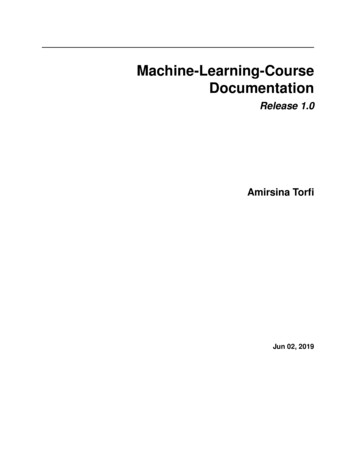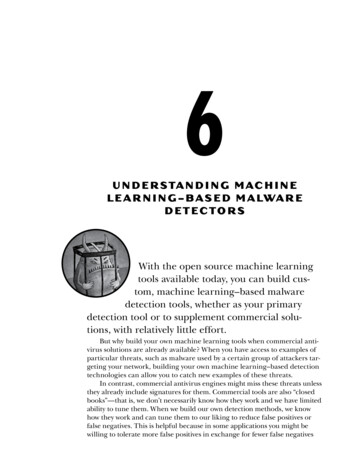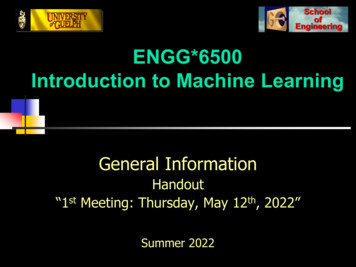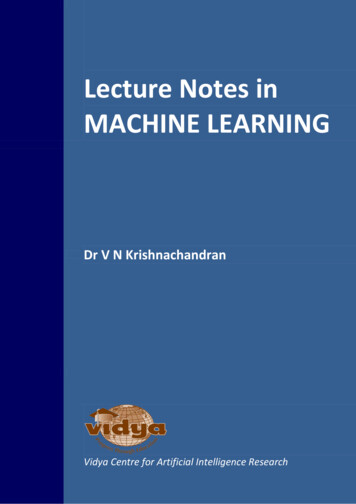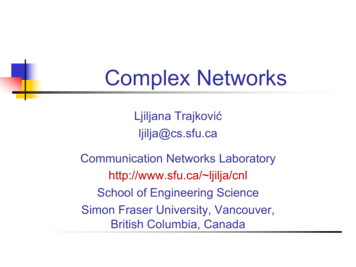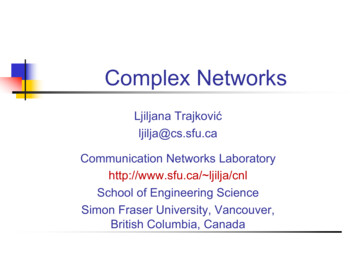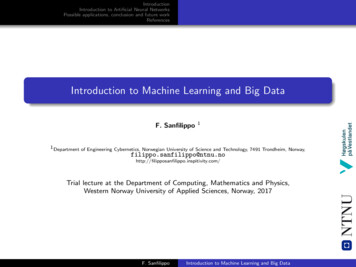
Transcription
IntroductionIntroduction to Artificial Neural NetworksPossible applications, conclusion and future workReferencesIntroduction to Machine Learning and Big DataF. Sanfilippo11 Department of Engineering Cybernetics, Norwegian University of Science and Technology, 7491 Trondheim, filippo.inspitivity.com/Trial lecture at the Department of Computing, Mathematics and Physics,Western Norway University of Applied Sciences, Norway, 2017F. SanfilippoIntroduction to Machine Learning and Big Data
IntroductionIntroduction to Artificial Neural NetworksPossible applications, conclusion and future workReferencesIntroductionWhat is Machine Learning?What is Big Data?The huge potential of Machine Learning and Big DataAbout MeEducation:PhD in Engineering Cybernetics,Norwegian University of Science andTechnology (NTNU), NorwayMSc in Computer Science Engineering,University of Siena, ItalyBSc degree in Computer ScienceEngineering, University of Catania, ItalyMobility:Visiting Fellow, Technical Aspects ofMultimodal Systems (TAMS),Department of Mathematics,Informatics and Natural Sciences,University of Hamburg, Hamburg,GermanyVisiting Student, School of Computingand Intelligent Systems, University ofUlster, Londonderry, United KingdomGranted with an Erasmus Sta Mobility for Teaching and TrainingprojectActivities:Membership Development Officer for the IEEENorway SectionF. SanfilippoIntroduction to Machine Learning and Big Data
IntroductionIntroduction to Artificial Neural NetworksPossible applications, conclusion and future workReferencesIntroductionWhat is Machine Learning?What is Big Data?The huge potential of Machine Learning and Big DataAbout MeCurrent research topic:Filippo Sanfilippo, Postdoctoral Fellowat the Dept. of Eng. Cybernetics,Norwegian University of Science andTechnology (NTNU), Trondheim,Norway“SNAKE - Control Strategies for Snake Robot Locomotion inChallenging Outdoor Environments”, project number 240072,supported by the Research Council of Norway through theYoung research talents funding schemeDesiredvelocityObstacles, posePerception/mappingCurrent courses:TTK4235 - Embedded Systems(Lecturer)Motion planningDesired shape/path (position, velocity)Experts in Teamwork - Snake robots(Supervisor)High-level controlPositionActual contacts, actualshape, actual velocityPast courses:VelocityVelocitycontrollerMotor torquesReal-time Computer Programming(Lecturer)Mechatronics, Robots and DeckMachines (Teaching Assistant)PositioncontrollerControl frameworkCurrent position:TactileperceptualdataVirtual/real snake robotGazebo RVizMamba robotVisualperceptualdataSystem Simulation in Matlab/Simulink(Lecturer)F. SanfilippoIntroduction to Machine Learning and Big DataExternalsystemcommands
IntroductionIntroduction to Artificial Neural NetworksPossible applications, conclusion and future workReferencesIntroductionWhat is Machine Learning?What is Big Data?The huge potential of Machine Learning and Big DataResearch topicsVisualisation/Game DevelopmentMobile DeviceAugmented Reality/Virtual RealitySoftware/HardwareCodesignMicro-controllers, IoT, Maker Tech.Real-time SystemsArtificial IntelligenceSafety-Critical SystemsF. SanfilippoEducationIntroduction to Machine Learning and Big Data
IntroductionIntroduction to Artificial Neural NetworksPossible applications, conclusion and future workReferencesIntroductionWhat is Machine Learning?What is Big Data?The huge potential of Machine Learning and Big DataIntroduction to Machine Learning and Big DataGoals of this trial lecture:fundamental cocetps (“idea buckets”) of ML and BDfundation for further learning about ML and BDspikes to further resources for self-learning about ML and BDF. SanfilippoIntroduction to Machine Learning and Big Data
IntroductionIntroduction to Artificial Neural NetworksPossible applications, conclusion and future workReferencesIntroductionWhat is Machine Learning?What is Big Data?The huge potential of Machine Learning and Big DataWhat is Machine Learning?Do not worry, not this!EnvironmentInputstakes actionsOutputsHuman ExperiencesLearningLearning:humans display intelligent behaviours by learning from experienceremembering, adapting and generalising (this is what makes learning useful!)F. SanfilippoIntroduction to Machine Learning and Big Data
IntroductionIntroduction to Artificial Neural NetworksPossible applications, conclusion and future workReferencesIntroductionWhat is Machine Learning?What is Big Data?The huge potential of Machine Learning and Big DataWhat is Machine Learning?Machine Learning:Arthur Samuel (1959). “Field of study that gives computers the ability to learnwithout being explicitly programmed”The Samuel Checkers-playing Program appears to be the world’s first self-learningprogram[1][1] Arthur L Samuel. “Some studies in machine learning using the game of checkers”. In: IBM Journal of researchand development 44.1.2 (2000), pp. 206–226.F. SanfilippoIntroduction to Machine Learning and Big Data
IntroductionIntroduction to Artificial Neural NetworksPossible applications, conclusion and future workReferencesIntroductionWhat is Machine Learning?What is Big Data?The huge potential of Machine Learning and Big DataWhat is Big Data?[2][2] Martin Hilbert and Priscila López. “The world’s technological capacity to store, communicate, and computeinformation”. In: science 332.6025 (2011), pp. 60–65.F. SanfilippoIntroduction to Machine Learning and Big Data
IntroductionIntroduction to Artificial Neural NetworksPossible applications, conclusion and future workReferencesIntroductionWhat is Machine Learning?What is Big Data?The huge potential of Machine Learning and Big DataWhat is Big Data?Big Data:high-volume,high-velocity and orhigh-varietyinformation assetsthat demandcost-e ective,innovative forms ofinformationprocessingenable enhancedinsight, decisionmaking, and processautomation[3][3] John Gantz and David Reinsel. “The digital universe in 2020: Big data, bigger digital shadows, and biggestgrowth in the far east”. In: IDC iView: IDC Analyze the future 2007.2012 (2012), pp. 1–16.F. SanfilippoIntroduction to Machine Learning and Big Data
IntroductionIntroduction to Artificial Neural NetworksPossible applications, conclusion and future workReferencesIntroductionWhat is Machine Learning?What is Big Data?The huge potential of Machine Learning and Big DataThe huge potential of Machine Learning and Big DataGoogle’s artificial brain learns to find cats and faces:ANN, 1 billion connections, 16000 computers, browse YouTube for 3 days[4][4] Quoc V Le. “Building high-level features using large scale unsupervised learning”. In: Acoustics, Speech andSignal Processing (ICASSP), 2013 IEEE International Conference on. IEEE. 2013, pp. 8595–8598.F. SanfilippoIntroduction to Machine Learning and Big Data
IntroductionIntroduction to Artificial Neural NetworksPossible applications, conclusion and future workReferencesANN biological inspirationModeling artificial neurons: perceptronsThe perceptron learning ruleNeural Network Train-Validate-Test StoppingANN biological inspirationOne hundred billion (100,000,000,000) neurons inside the human brain each withabout one thousand synaptic connectionsIt’s e ectively the way in which these synapses are wired that give our brains theability to process information the way they do.F. SanfilippoIntroduction to Machine Learning and Big Data
IntroductionIntroduction to Artificial Neural NetworksPossible applications, conclusion and future workReferencesANN biological inspirationModeling artificial neurons: perceptronsThe perceptron learning ruleNeural Network Train-Validate-Test StoppingModeling artificial neurons: perceptronsx1x2 0.6 1.0w1 0 . 5w2 0 . 8// I n p u t 1// I n p u t 2// Weight 1// Weight 2Threshold 1.0x1w1 x2w2 ( 0 . 6 x 0 . 5 ) ( 1 x 0 . 8 ) 1 . 1F. SanfilippoIntroduction to Machine Learning and Big Data
IntroductionIntroduction to Artificial Neural NetworksPossible applications, conclusion and future workReferencesANN biological inspirationModeling artificial neurons: perceptronsThe perceptron learning ruleNeural Network Train-Validate-Test StoppingImplementing Artificial Neural Networksfeedforward network: the signals are passed through the layers of the neuralnetwork in a single directionThese aren’t the only type of neural network though. There are also feedbacknetworks where their architecture allows signals to travel in both directionsF. SanfilippoIntroduction to Machine Learning and Big Data
IntroductionIntroduction to Artificial Neural NetworksPossible applications, conclusion and future workReferencesANN biological inspirationModeling artificial neurons: perceptronsThe perceptron learning ruleNeural Network Train-Validate-Test StoppingLinear separability and multi layer perceptron0011OR010101110011XOR01010110F. SanfilippoIntroduction to Machine Learning and Big Data
IntroductionIntroduction to Artificial Neural NetworksPossible applications, conclusion and future workReferencesANN biological inspirationModeling artificial neurons: perceptronsThe perceptron learning ruleNeural Network Train-Validate-Test StoppingThe perceptron learning ruleo f(nXxi wi ),(1)i 1E to,(2)wi rExi ,wi r (t(3)o)xi ,wi (t 1) wi (t) (4)wi ,(5)If the learning rate is too high the perceptron can jump too far and miss the solution,if it’s too low, it can take an unreasonably long time to train.F. SanfilippoIntroduction to Machine Learning and Big Data
IntroductionIntroduction to Artificial Neural NetworksPossible applications, conclusion and future workReferencesANN biological inspirationModeling artificial neurons: perceptronsThe perceptron learning ruleNeural Network Train-Validate-Test StoppingAND function examplertoE 0.1 1 0 1// Weightwi r Ew1 0 . 1w2 0 . 1rtoEUpdatex wi 1 1 w1 1 1 w2//New W e i g h t sw1 0 . 4w2 0 . 4 0.1 1 0 1rtoE// Weightwi r Ew1 0 . 1w2 0 . 1Updatex wi 1 1 w1 1 1 w2 0.1 1 1 0//No e r r o r//New W e i g h t s :w1 0 . 5w2 0 . 5F. SanfilippoIntroduction to Machine Learning and Big Data
IntroductionIntroduction to Artificial Neural NetworksPossible applications, conclusion and future workReferencesANN biological inspirationModeling artificial neurons: perceptronsThe perceptron learning ruleNeural Network Train-Validate-Test StoppingNeural Network Train-Validate-Test Stoppingthe data is split into three sets: a training set (typically 60 percent of the data), avalidation set (20 percent) and a test set (20 percent)F. SanfilippoIntroduction to Machine Learning and Big Data
IntroductionIntroduction to Artificial Neural NetworksPossible applications, conclusion and future workReferencesPossible applicationsConclusionAn architecture for di erent models of maritime cranes and robotic arms[5–8][5] Filippo Sanfilippo et al. “A mapping approach for controlling di erent maritime cranes and robots using ANN”.In: Proc. of the IEEE International Conference on Mechatronics and Automation (ICMA). 2014, pp. 594–599.[6] Filippo Sanfilippo et al. “A Universal Control Architecture for Maritime Cranes and Robots Using Genetic Algorithms as a Possible Mapping Approach”.In: Proc. of the IEEE International Conference on Robotics andBiomimetics (ROBIO), Shenzhen, China. 2013, pp. 322–327.[7] Filippo Sanfilippo et al. “Integrated flexible maritime crane architecture for the o shore simulation centre AS(OSC): A flexible framework for alternative maritime crane control algorithms”.In: IEEE Journal of OceanicEngineering 41.2 (2016), pp. 450–461.[8] Filippo Sanfilippo et al. “A Benchmarking Framework for Control Methods of Maritime Cranes Based on theFunctional Mockup Interface”. In: IEEE Journal of Oceanic Engineering (2017).F. SanfilippoIntroduction to Machine Learning and Big Data
IntroductionIntroduction to Artificial Neural NetworksPossible applications, conclusion and future workReferencesPossible applicationsConclusionConclusionHuge potential for ML and BD:intelligent decision making systemsprediction methodsapplications (social networks, biology, life sciences datasets)swarm IntelligenceBD Cybernetics, from a large number of sensor channels into smart data[9][9] Cui-Ru Wang, Chun-Lei Zhou, and Jian-Wei Ma. “Machine learning and cybernetics”. In: Proceedings of 2005International Conference on An improved artificial fish-swarm algorithm and its application in feed-forward neuralnetworks. Vol. 5. Springer. 2003, pp. 2890–2894.F. SanfilippoIntroduction to Machine Learning and Big Data
IntroductionIntroduction to Artificial Neural NetworksPossible applications, conclusion and future workReferencesPossible applicationsConclusionThank you for your attentionML and BD useful resources:http://playground.tensorflow.org/, a Neural Network right in your browserhttps://www.tensorflow.org/, an open-source software library for MachineIntelligenceContact:F. Sanfilippo, Department of Engineering Cybernetics, Norwegian University ofScience and Technology, 7491 Trondheim, Norway, filippo.sanfilippo@ntnu.no.F. SanfilippoIntroduction to Machine Learning and Big Data
IntroductionIntroduction to Artificial Neural NetworksPossible applications, conclusion and future workReferencesReferences[1]Arthur L Samuel. “Some studies in machine learning using the game of checkers”.In: IBM Journal of research and development 44.1.2 (2000), pp. 206–226.[2]Martin Hilbert and Priscila López. “The world’s technological capacity to store,communicate, and compute information”. In: science 332.6025 (2011),pp. 60–65.[3]John Gantz and David Reinsel. “The digital universe in 2020: Big data, biggerdigital shadows, and biggest growth in the far east”. In: IDC iView: IDC Analyzethe future 2007.2012 (2012), pp. 1–16.[4]Quoc V Le. “Building high-level features using large scale unsupervised learning”.In: Acoustics, Speech and Signal Processing (ICASSP), 2013 IEEE InternationalConference on. IEEE. 2013, pp. 8595–8598.[5]Filippo Sanfilippo et al. “A mapping approach for controlling di erent maritimecranes and robots using ANN”. In: Proc. of the IEEE International Conferenceon Mechatronics and Automation (ICMA). 2014, pp. 594–599.[6]Filippo Sanfilippo et al. “A Universal Control Architecture for Maritime Cranesand Robots Using Genetic Algorithms as a Possible Mapping Approach”. In:Proc. of the IEEE International Conference on Robotics and Biomimetics(ROBIO), Shenzhen, China. 2013, pp. 322–327.F. SanfilippoIntroduction to Machine Learning and Big Data
IntroductionIntroduction to Artificial Neural NetworksPossible applications, conclusion and future workReferencesReferences (contd.)[7]Filippo Sanfilippo et al. “Integrated flexible maritime crane architecture for theo shore simulation centre AS (OSC): A flexible framework for alternativemaritime crane control algorithms”. In: IEEE Journal of Oceanic Engineering41.2 (2016), pp. 450–461.[8]Filippo Sanfilippo et al. “A Benchmarking Framework for Control Methods ofMaritime Cranes Based on the Functional Mockup Interface”. In: IEEE Journalof Oceanic Engineering (2017).[9]Cui-Ru Wang, Chun-Lei Zhou, and Jian-Wei Ma. “Machine learning andcybernetics”. In: Proceedings of 2005 International Conference on An improvedartificial fish-swarm algorithm and its application in feed-forward neural networks.Vol. 5. Springer. 2003, pp. 2890–2894.F. SanfilippoIntroduction to Machine Learning and Big Data
The huge potential of Machine Learning and Big Data Introduction to Machine Learning and Big Data Goals of this trial lecture: fundamental cocetps ("idea buckets") of ML and BD fundation for further learning about ML and BD spikes to further resources for self-learning about ML and BD F. Sanfilippo Introduction to Machine Learning and Big Data



